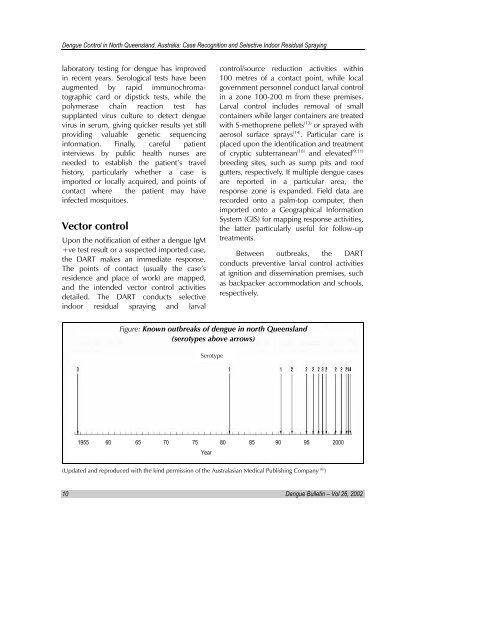Dengue Bulletin
Dengue Bulletin
Dengue Bulletin
- TAGS
- dengue
- bulletin
- 203.90.70.117
You also want an ePaper? Increase the reach of your titles
YUMPU automatically turns print PDFs into web optimized ePapers that Google loves.
<strong>Dengue</strong> Control in North Queensland, Australia: Case Recognition and Selective Indoor Residual Spraying<br />
laboratory testing for dengue has improved<br />
in recent years. Serological tests have been<br />
augmented by rapid immunochromatographic<br />
card or dipstick tests, while the<br />
polymerase chain reaction test has<br />
supplanted virus culture to detect dengue<br />
virus in serum, giving quicker results yet still<br />
providing valuable genetic sequencing<br />
information. Finally, careful patient<br />
interviews by public health nurses are<br />
needed to establish the patient’s travel<br />
history, particularly whether a case is<br />
imported or locally acquired, and points of<br />
contact where the patient may have<br />
infected mosquitoes.<br />
Vector control<br />
Upon the notification of either a dengue IgM<br />
+ve test result or a suspected imported case,<br />
the DART makes an immediate response.<br />
The points of contact (usually the case’s<br />
residence and place of work) are mapped,<br />
and the intended vector control activities<br />
detailed. The DART conducts selective<br />
indoor residual spraying and larval<br />
control/source reduction activities within<br />
100 metres of a contact point, while local<br />
government personnel conduct larval control<br />
in a zone 100-200 m from these premises.<br />
Larval control includes removal of small<br />
containers while larger containers are treated<br />
with S-methoprene pellets (13) or sprayed with<br />
aerosol surface sprays (14) . Particular care is<br />
placed upon the identification and treatment<br />
of cryptic subterranean (10) and elevated (9,11)<br />
breeding sites, such as sump pits and roof<br />
gutters, respectively. If multiple dengue cases<br />
are reported in a particular area, the<br />
response zone is expanded. Field data are<br />
recorded onto a palm-top computer, then<br />
imported onto a Geographical Information<br />
System (GIS) for mapping response activities,<br />
the latter particularly useful for follow-up<br />
treatments.<br />
Between outbreaks, the DART<br />
conducts preventive larval control activities<br />
at ignition and dissemination premises, such<br />
as backpacker accommodation and schools,<br />
respectively.<br />
Figure: Known outbreaks of dengue in north Queensland<br />
(serotypes above arrows)<br />
Serotype<br />
1955 60 65 70 75 80<br />
Year<br />
85 90 95 2000<br />
(Updated and reproduced with the kind permission of the Australasian Medical Publishing Company (6) )<br />
10 <strong>Dengue</strong> <strong>Bulletin</strong> – Vol 26, 2002









